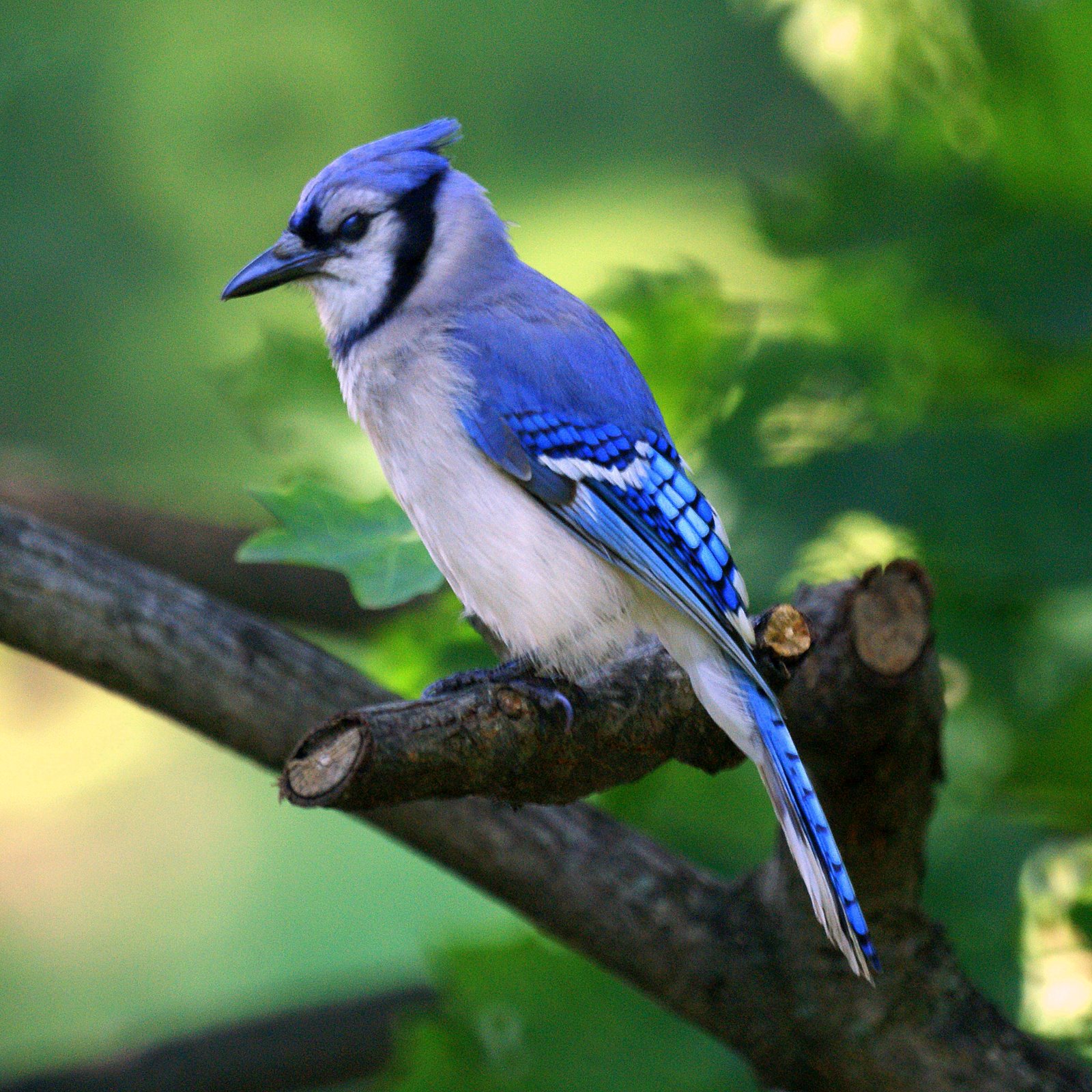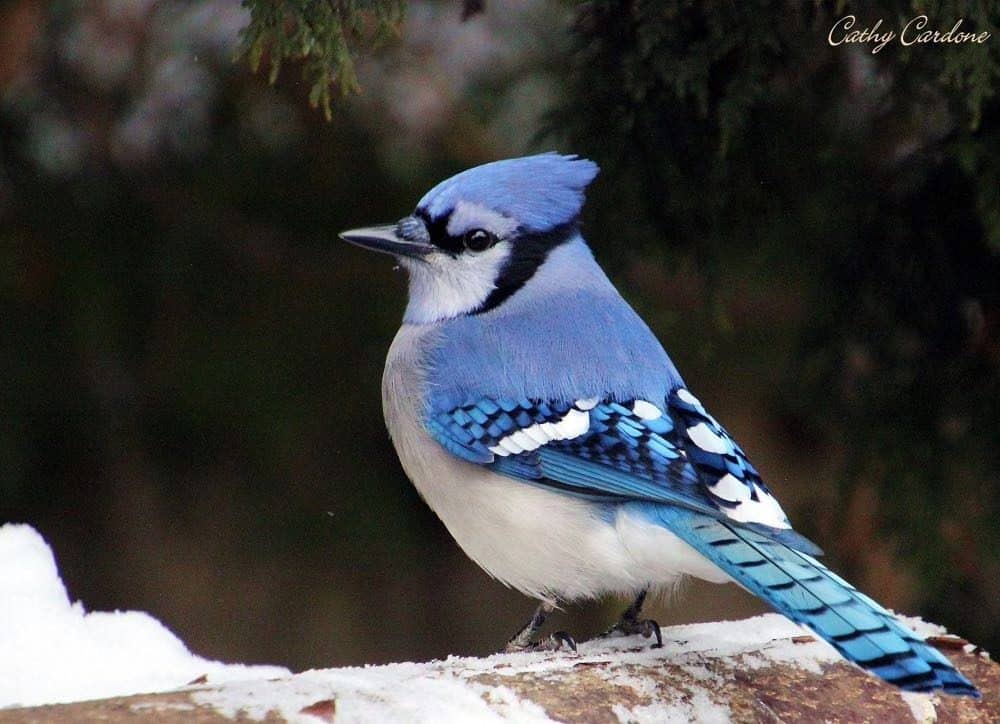Blue Jay Biology and Behavior: Blue Jays

Blue jays are a common and striking sight in North American woodlands. These intelligent and vocal birds are easily recognizable with their distinctive blue, white, and black plumage. Their behavior is equally fascinating, showcasing a complex mix of social interactions, territoriality, and adaptability.
Physical Characteristics
Blue jays are medium-sized birds, measuring approximately 10-12 inches in length with a wingspan of 16-20 inches. Their most prominent feature is their vibrant blue plumage, which covers their head, back, wings, and tail. Their underparts are white, and their wings and tail are edged with black. A black “collar” surrounds their neck, separating the blue plumage from the white underparts. Blue jays also have a distinctive black crest on their head, which they can raise or lower depending on their mood.
Blue jays are known for their loud, raucous calls, which can be described as a series of harsh “jay” or “jea” sounds. These calls are used for a variety of purposes, including communication, territorial defense, and alarm calls. Their calls are often described as being similar to the sound of a human shouting, and they can be heard from a considerable distance.
Diet and Feeding Habits
Blue jays are opportunistic feeders, meaning they will eat a variety of foods depending on what is available. Their diet consists mainly of nuts, seeds, fruits, and insects. They are particularly fond of acorns, beechnuts, and sunflower seeds. They also readily consume insects, including caterpillars, beetles, and grasshoppers.
Blue jays are known for their ability to cache food, hiding it in various locations for later retrieval. This behavior allows them to store food during times of abundance and access it during times of scarcity. They often cache their food in trees, under logs, or in the ground.
Nesting Habits
Blue jays are typically monogamous birds, forming pair bonds that can last for several years. They build their nests in trees, usually high up in the canopy, often choosing coniferous trees or deciduous trees with dense foliage. The nests are typically constructed from twigs, bark, and grasses, and are lined with softer materials such as feathers, moss, and hair.
The female blue jay typically lays 3-7 eggs, which are incubated for about 18 days. Both parents participate in incubating the eggs and feeding the young. The young birds remain in the nest for about 3 weeks, during which time they are fed by their parents.
Social Behavior
Blue jays are highly social birds, living in flocks outside of the breeding season. They are known for their territoriality, defending their territories from other blue jays and other bird species. They use their loud calls and aggressive displays to deter intruders.
Blue jays communicate with each other using a variety of calls, postures, and gestures. They use specific calls to signal danger, alarm, or the presence of food. They also use their crests to communicate their mood, raising them when they are agitated or threatened and lowering them when they are relaxed.
Blue jays are known for their intelligence and problem-solving abilities. They have been observed using tools to retrieve food and remembering the locations of their cached food supplies. They are also known for their ability to mimic the calls of other birds and even human voices.
Blue Jays in the Ecosystem
Blue jays are more than just colorful birds with a raucous call; they play a vital role in maintaining the health and balance of their forest ecosystems. Their actions have a ripple effect, impacting everything from plant diversity to insect populations.
Seed Dispersal and Forest Regeneration
Blue jays are known for their hoarding behavior, caching thousands of seeds each year. They bury these seeds in various locations, often forgetting where they hid some. This forgetfulness, however, is crucial for forest regeneration. When seeds are left undisturbed, they have a higher chance of germinating and growing into new trees. This process, known as seed dispersal, helps to establish new populations of trees and maintain the diversity of the forest.
Control of Insect Populations, Blue jays
Blue jays are opportunistic feeders, consuming a wide variety of insects, including caterpillars, beetles, and grasshoppers. They are particularly effective at controlling populations of forest pests that can damage trees. Their diet helps to keep insect populations in check, preventing outbreaks that could decimate entire forests.
Interactions with Other Bird Species
Blue jays are highly social birds, often interacting with other species. These interactions can range from competition for resources to cooperative behaviors. For example, blue jays may compete with other birds for food sources, particularly during the breeding season. However, they can also cooperate with other birds to defend their territories against predators.
Impact of Habitat Loss and Fragmentation
Habitat loss and fragmentation pose significant threats to blue jay populations. As forests are cleared for development or agriculture, blue jays lose their nesting and foraging grounds. Fragmentation, the division of large habitats into smaller, isolated patches, can also impact blue jay populations by limiting their access to resources and increasing their vulnerability to predators.
Blue Jays in Culture and Folklore

The blue jay, with its striking plumage and boisterous calls, has captured the imaginations of people for centuries. Its presence in various cultures and mythologies reflects a deep-rooted connection between humans and this iconic bird.
Blue Jays in Native American Cultures
The blue jay holds significant cultural and spiritual meaning in many Native American traditions. Its symbolism varies across different tribes, often reflecting the bird’s characteristics and behaviors.
- Messenger of the Gods: In some tribes, the blue jay is seen as a messenger of the gods, delivering messages between the spiritual realm and the human world. Its intelligence and ability to mimic sounds are often associated with its role as a communicator.
- Symbol of Wisdom and Intelligence: The blue jay’s ability to learn and adapt, as well as its complex social structure, has led to its association with wisdom and intelligence in various cultures. Some tribes believe that the blue jay possesses knowledge that can be accessed through careful observation and understanding.
- Trickster Figure: In other traditions, the blue jay is portrayed as a trickster figure, known for its mischievous and playful nature. This portrayal highlights the bird’s ability to outwit others, often using its intelligence and cunning to its advantage.
- Symbol of Transformation: The blue jay’s striking blue plumage has also led to its association with transformation and change. Its ability to shed its feathers and regrow new ones symbolizes renewal and rebirth, representing the cyclical nature of life.
Blue Jays in Literature and Art
The blue jay’s vibrant colors and bold personality have inspired artists and writers for generations. Its appearance in literature and art often reflects its symbolic significance and cultural associations.
- Literature: The blue jay has been featured in numerous literary works, often symbolizing various themes. In Henry David Thoreau’s *Walden*, the blue jay represents the wildness and untamed nature of the forest. In other works, the blue jay’s loud calls and bold behavior have been used to symbolize human nature, highlighting our capacity for both good and evil.
- Art: Blue jays have been depicted in paintings, sculptures, and other forms of art, capturing their beauty and personality. The bird’s vibrant colors and distinctive markings have made it a popular subject for artists, particularly those interested in wildlife and nature.
Blue Jays as Mascots
The blue jay’s vibrant colors and bold personality have made it a popular choice as a mascot for sports teams and other organizations. Its association with strength, intelligence, and agility has made it a fitting symbol for teams striving for victory.
- Sports: The most famous blue jay mascot is the one used by the Major League Baseball team, the Toronto Blue Jays. The team’s name and logo, featuring a stylized blue jay, have become synonymous with the franchise. Other sports teams, such as the Blue Jay High School in Texas, have also adopted the blue jay as their mascot.
- Organizations: The blue jay has also been used as a mascot by various organizations, including schools, universities, and community groups. Its symbolic meaning and cultural significance make it a popular choice for organizations seeking to represent their values and identity.
Blue Jay Names Around the World
The blue jay’s distinctive appearance and calls have led to various names for the bird in different languages and regions. This table highlights some of the common names for the blue jay around the world:
| Language | Name |
|---|---|
| English | Blue Jay |
| Spanish | Arrendajo Azul |
| French | Geai Bleu |
| German | Blauhäher |
| Italian | Ghiandaia azzurra |
| Japanese | アオガラ (Aogara) |
| Chinese | 藍鵲 (Lán què) |
Blue Jays are totally rad, but if you’re talking about baseball, the Rockies and Diamondbacks are like the ultimate rivals, you know? They go head-to-head in the National League West, and it’s always a total blast to watch, especially when they’re both going for the win.
Check out this article about their rivalry – it’s totally worth the read! Anyway, back to the Blue Jays, they’re a pretty cool team too, but these two teams, they’re just something else.
Blue Jays are totally cool, right? They’re like the coolest birds in the whole park, always chillin’ and lookin’ fly. But you know what’s even cooler than a blue jay? The Atlanta Braves ! They’re like the blue jays of baseball, always crushing it and bringing the heat.
And just like the blue jays, they’re always ready to fly high and take on any challenge!

